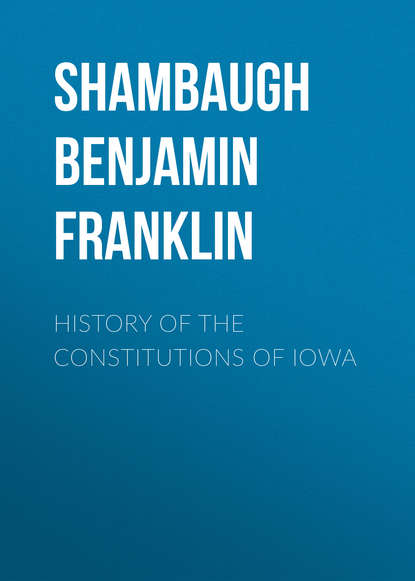По всем вопросам обращайтесь на: info@litportal.ru
(©) 2003-2024.
✖
History of the Constitutions of Iowa
Настройки чтения
Размер шрифта
Высота строк
Поля
As regards this conclusion two criticisms are anticipated. First, it will be said that since the Territory of Iowa was organized in 1838, the Territorial epoch in our history could not have begun in 1836. Secondly, it will be said that an act of Congress providing for and establishing a Territory is not a Constitution.
The answer to the first criticism lies in the fact that the Iowa country was not an outlying district attached to the Territory of Wisconsin, but really formed a constituent part thereof. The area of Wisconsin Territory west of the Mississippi was far more extensive than the area of the same Territory east of the river. In population the two areas were nearly equal; but the west tended to increase more rapidly than the east. The importance of the west is further evidenced by the removal of the Capital after the first session of the Legislative Assembly from Belmont in eastern Wisconsin to Burlington in western Wisconsin. The constitutional history of Wisconsin up to the division of the Territory in 1838 is, therefore, clearly a part of the Territorial history of Iowa. The assignment of the old name "Wisconsin" to the country east of the Mississippi and of the new name "Iowa" to the country west of that river in 1838, when the Territory of Wisconsin was divided, did not give rise to Territorial government among our people. The act of Congress of June 12, 1838, provided for the division of an existing Territory and the continuation of Territorial government in the western part thereof under the name Iowa.
When, however, all this is conceded, the propriety of referring to the Organic Act of a Territory as a Constitution is questioned. It is true that the act establishing the Territorial government of Wisconsin was not drawn up by the people of the Territory. It was not even submitted to them for ratification. Handed down to them by Congress, in the form of an ordinary statute, it was a pure product of legislation. It did not even have the label "Constitution," or "Fundamental Compact," or "Organic Law." Nevertheless, this instrument was a veritable Constitution, since it was a written body of fundamental law in accordance with which the government of the Territory was instituted and administered. It was supreme, serving as the absolute rule of action for all departments and officers of the Territorial government. The courts always took this view of the Organic Act, and refused to enforce acts which were clearly in opposition to its provisions.
VI
THE TERRITORY OF IOWA
In the year 1836 there was printed and published at Philadelphia a small book bearing on its title-page these words:
NOTES ON
WISCONSIN TERRITORY,
WITH A MAP
BY
LIEUTENANT ALBERT M. LEA,
UNITED STATES DRAGOONS
PHILADELPHIA
HENRY S. TANNER-SHAKESPEAR BUILDING
1836
The significance of this little volume lies in the fact that through it the country destined to give birth to "the only free child of the Missouri Compromise" was christened IOWA. Lieutenant Lea was familiar with the country described in his "Notes." He had traveled through it, had seen its beautiful prairies, had met its inhabitants face to face, and had enjoyed their frontier hospitality. He must have been deeply impressed by the Iowa river and its name. Referring to the country west of the Mississippi river he says: "The District under review has been often called 'Scott's Purchase,' and it is sometimes called the 'Black-Hawk Purchase'; but from the extent and beauty of the Iowa river which runs centrally through the District, and gives character to most of it, the name of that stream, being both euphonous and appropriate, has been given to the District itself."
The Iowa District was likely to become a separate Territory at an early day, since all indications pointed in the direction of a division of the Territory of Wisconsin. First, the geographical area of the Territory as designated in the Organic Act was sufficient for three or four ordinary Commonwealths. Secondly, this area did not possess geographical unity. Thirdly, historical traditions and considerations favored the establishment of a separate Territory east of the Mississippi, which at the proper time should be admitted as the fifth State born of the Ordinance of 1787 within the limits of the old Territory of the Northwest. Fourthly, the population of the Territory, which was increasing with unparalleled rapidity, was so widely scattered as to make it practically impossible to give equal force to the laws and equal efficiency to the administration of government in all of the frontier communities. That the "Father of Waters" should serve as the natural line of division was generally conceded.
Scarcely had the act organizing the Territory of Wisconsin gone into effect, when the agitation for division was launched. By the fall of 1837 it had captured the public mind. The burden of the movement was taken up with enthusiasm by the inhabitants of the Iowa District. They realized that the proposition to remove the seat of the Territorial government from Burlington to some point east of the Mississippi was likely to rob them of much political influence and some distinction. They felt that a Territorial government located somewhere "in the vicinity of the Four Lakes" could not successfully administer constitutional government in the Iowa District.





